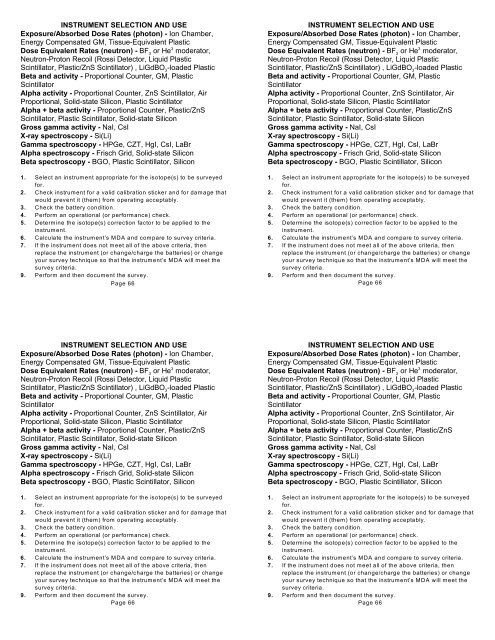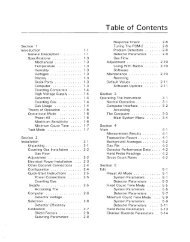Gilson and Voss - Voss Associates
Gilson and Voss - Voss Associates
Gilson and Voss - Voss Associates
Create successful ePaper yourself
Turn your PDF publications into a flip-book with our unique Google optimized e-Paper software.
INSTRUMENT SELECTION AND USE<br />
Exposure/Absorbed Dose Rates (photon) - Ion Chamber,<br />
Energy Compensated GM, Tissue-Equivalent Plastic<br />
3<br />
Dose Equivalent Rates (neutron) - BF<br />
3<br />
or He moderator,<br />
Neutron-Proton Recoil (Rossi Detector, Liquid Plastic<br />
Scintillator, Plastic/ZnS Scintillator) , LiGdBO3-loaded Plastic<br />
Beta <strong>and</strong> activity - Proportional Counter, GM, Plastic<br />
Scintillator<br />
Alpha activity - Proportional Counter, ZnS Scintillator, Air<br />
Proportional, Solid-state Silicon, Plastic Scintillator<br />
Alpha + beta activity - Proportional Counter, Plastic/ZnS<br />
Scintillator, Plastic Scintillator, Solid-state Silicon<br />
Gross gamma activity - NaI, CsI<br />
X-ray spectroscopy - Si(Li)<br />
Gamma spectroscopy - HPGe, CZT, HgI, CsI, LaBr<br />
Alpha spectroscopy - Frisch Grid, Solid-state Silicon<br />
Beta spectroscopy - BGO, Plastic Scintillator, Silicon<br />
1. Select an instrument appropriate for the isotope(s) to be surveyed<br />
for.<br />
2. Check instrument for a valid calibration sticker <strong>and</strong> for damage that<br />
would prevent it (them) from operating acceptably.<br />
3. Check the battery condition.<br />
4. Perform an operational (or performance) check.<br />
5. Determine the isotope(s) correction factor to be applied to the<br />
instrument.<br />
6. Calculate the instrument’s MDA <strong>and</strong> compare to survey criteria.<br />
7. If the instrument does not meet all of the above criteria, then<br />
replace the instrument (or change/charge the batteries) or change<br />
your survey technique so that the instrument’s MDA will meet the<br />
survey criteria.<br />
9. Perform <strong>and</strong> then document the survey.<br />
Page 66<br />
INSTRUMENT SELECTION AND USE<br />
Exposure/Absorbed Dose Rates (photon) - Ion Chamber,<br />
Energy Compensated GM, Tissue-Equivalent Plastic<br />
3<br />
Dose Equivalent Rates (neutron) - BF<br />
3<br />
or He moderator,<br />
Neutron-Proton Recoil (Rossi Detector, Liquid Plastic<br />
Scintillator, Plastic/ZnS Scintillator) , LiGdBO3-loaded Plastic<br />
Beta <strong>and</strong> activity - Proportional Counter, GM, Plastic<br />
Scintillator<br />
Alpha activity - Proportional Counter, ZnS Scintillator, Air<br />
Proportional, Solid-state Silicon, Plastic Scintillator<br />
Alpha + beta activity - Proportional Counter, Plastic/ZnS<br />
Scintillator, Plastic Scintillator, Solid-state Silicon<br />
Gross gamma activity - NaI, CsI<br />
X-ray spectroscopy - Si(Li)<br />
Gamma spectroscopy - HPGe, CZT, HgI, CsI, LaBr<br />
Alpha spectroscopy - Frisch Grid, Solid-state Silicon<br />
Beta spectroscopy - BGO, Plastic Scintillator, Silicon<br />
1. Select an instrument appropriate for the isotope(s) to be surveyed<br />
for.<br />
2. Check instrument for a valid calibration sticker <strong>and</strong> for damage that<br />
would prevent it (them) from operating acceptably.<br />
3. Check the battery condition.<br />
4. Perform an operational (or performance) check.<br />
5. Determine the isotope(s) correction factor to be applied to the<br />
instrument.<br />
6. Calculate the instrument’s MDA <strong>and</strong> compare to survey criteria.<br />
7. If the instrument does not meet all of the above criteria, then<br />
replace the instrument (or change/charge the batteries) or change<br />
your survey technique so that the instrument’s MDA will meet the<br />
survey criteria.<br />
9. Perform <strong>and</strong> then document the survey.<br />
Page 66<br />
INSTRUMENT SELECTION AND USE<br />
Exposure/Absorbed Dose Rates (photon) - Ion Chamber,<br />
Energy Compensated GM, Tissue-Equivalent Plastic<br />
3<br />
Dose Equivalent Rates (neutron) - BF<br />
3<br />
or He moderator,<br />
Neutron-Proton Recoil (Rossi Detector, Liquid Plastic<br />
Scintillator, Plastic/ZnS Scintillator) , LiGdBO3-loaded Plastic<br />
Beta <strong>and</strong> activity - Proportional Counter, GM, Plastic<br />
Scintillator<br />
Alpha activity - Proportional Counter, ZnS Scintillator, Air<br />
Proportional, Solid-state Silicon, Plastic Scintillator<br />
Alpha + beta activity - Proportional Counter, Plastic/ZnS<br />
Scintillator, Plastic Scintillator, Solid-state Silicon<br />
Gross gamma activity - NaI, CsI<br />
X-ray spectroscopy - Si(Li)<br />
Gamma spectroscopy - HPGe, CZT, HgI, CsI, LaBr<br />
Alpha spectroscopy - Frisch Grid, Solid-state Silicon<br />
Beta spectroscopy - BGO, Plastic Scintillator, Silicon<br />
1. Select an instrument appropriate for the isotope(s) to be surveyed<br />
for.<br />
2. Check instrument for a valid calibration sticker <strong>and</strong> for damage that<br />
would prevent it (them) from operating acceptably.<br />
3. Check the battery condition.<br />
4. Perform an operational (or performance) check.<br />
5. Determine the isotope(s) correction factor to be applied to the<br />
instrument.<br />
6. Calculate the instrument’s MDA <strong>and</strong> compare to survey criteria.<br />
7. If the instrument does not meet all of the above criteria, then<br />
replace the instrument (or change/charge the batteries) or change<br />
your survey technique so that the instrument’s MDA will meet the<br />
survey criteria.<br />
9. Perform <strong>and</strong> then document the survey.<br />
Page 66<br />
INSTRUMENT SELECTION AND USE<br />
Exposure/Absorbed Dose Rates (photon) - Ion Chamber,<br />
Energy Compensated GM, Tissue-Equivalent Plastic<br />
3<br />
Dose Equivalent Rates (neutron) - BF<br />
3<br />
or He moderator,<br />
Neutron-Proton Recoil (Rossi Detector, Liquid Plastic<br />
Scintillator, Plastic/ZnS Scintillator) , LiGdBO3-loaded Plastic<br />
Beta <strong>and</strong> activity - Proportional Counter, GM, Plastic<br />
Scintillator<br />
Alpha activity - Proportional Counter, ZnS Scintillator, Air<br />
Proportional, Solid-state Silicon, Plastic Scintillator<br />
Alpha + beta activity - Proportional Counter, Plastic/ZnS<br />
Scintillator, Plastic Scintillator, Solid-state Silicon<br />
Gross gamma activity - NaI, CsI<br />
X-ray spectroscopy - Si(Li)<br />
Gamma spectroscopy - HPGe, CZT, HgI, CsI, LaBr<br />
Alpha spectroscopy - Frisch Grid, Solid-state Silicon<br />
Beta spectroscopy - BGO, Plastic Scintillator, Silicon<br />
1. Select an instrument appropriate for the isotope(s) to be surveyed<br />
for.<br />
2. Check instrument for a valid calibration sticker <strong>and</strong> for damage that<br />
would prevent it (them) from operating acceptably.<br />
3. Check the battery condition.<br />
4. Perform an operational (or performance) check.<br />
5. Determine the isotope(s) correction factor to be applied to the<br />
instrument.<br />
6. Calculate the instrument’s MDA <strong>and</strong> compare to survey criteria.<br />
7. If the instrument does not meet all of the above criteria, then<br />
replace the instrument (or change/charge the batteries) or change<br />
your survey technique so that the instrument’s MDA will meet the<br />
survey criteria.<br />
9. Perform <strong>and</strong> then document the survey.<br />
Page 66













